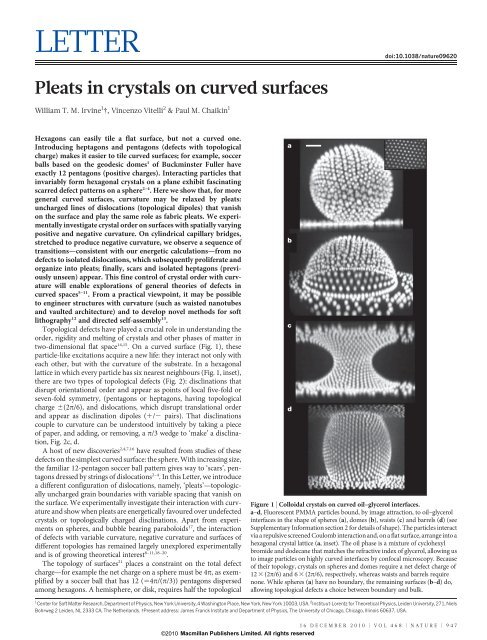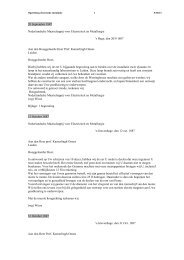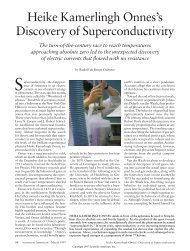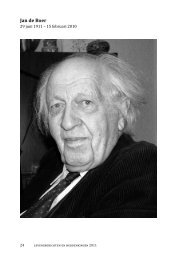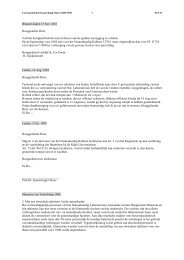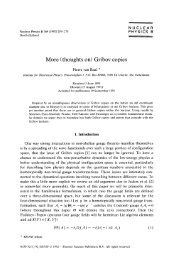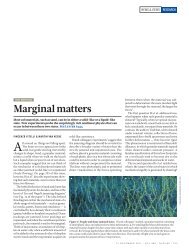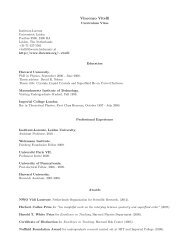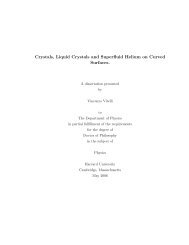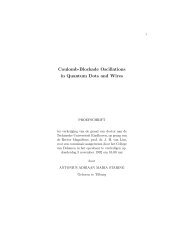Pleats in crystals on curved surfaces
Pleats in crystals on curved surfaces
Pleats in crystals on curved surfaces
Create successful ePaper yourself
Turn your PDF publications into a flip-book with our unique Google optimized e-Paper software.
LETTER doi:10.1038/nature09620<br />
<str<strong>on</strong>g>Pleats</str<strong>on</strong>g> <str<strong>on</strong>g>in</str<strong>on</strong>g> <str<strong>on</strong>g>crystals</str<strong>on</strong>g> <strong>on</strong> <strong>curved</strong> <strong>surfaces</strong><br />
William T. M. Irv<str<strong>on</strong>g>in</str<strong>on</strong>g>e 1 {, V<str<strong>on</strong>g>in</str<strong>on</strong>g>cenzo Vitelli 2 & Paul M. Chaik<str<strong>on</strong>g>in</str<strong>on</strong>g> 1<br />
Hexag<strong>on</strong>s can easily tile a flat surface, but not a <strong>curved</strong> <strong>on</strong>e.<br />
Introduc<str<strong>on</strong>g>in</str<strong>on</strong>g>g heptag<strong>on</strong>s and pentag<strong>on</strong>s (defects with topological<br />
charge) makes it easier to tile <strong>curved</strong> <strong>surfaces</strong>; for example, soccer<br />
balls based <strong>on</strong> the geodesic domes 1 of Buckm<str<strong>on</strong>g>in</str<strong>on</strong>g>ster Fuller have<br />
exactly 12 pentag<strong>on</strong>s (positive charges). Interact<str<strong>on</strong>g>in</str<strong>on</strong>g>g particles that<br />
<str<strong>on</strong>g>in</str<strong>on</strong>g>variably form hexag<strong>on</strong>al <str<strong>on</strong>g>crystals</str<strong>on</strong>g> <strong>on</strong> a plane exhibit fasc<str<strong>on</strong>g>in</str<strong>on</strong>g>at<str<strong>on</strong>g>in</str<strong>on</strong>g>g<br />
scarred defect patterns <strong>on</strong> a sphere 2–4 . Here we show that, for more<br />
general <strong>curved</strong> <strong>surfaces</strong>, curvature may be relaxed by pleats:<br />
uncharged l<str<strong>on</strong>g>in</str<strong>on</strong>g>es of dislocati<strong>on</strong>s (topological dipoles) that vanish<br />
<strong>on</strong> the surface and play the same role as fabric pleats. We experimentally<br />
<str<strong>on</strong>g>in</str<strong>on</strong>g>vestigate crystal order <strong>on</strong> <strong>surfaces</strong> with spatially vary<str<strong>on</strong>g>in</str<strong>on</strong>g>g<br />
positive and negative curvature. On cyl<str<strong>on</strong>g>in</str<strong>on</strong>g>drical capillary bridges,<br />
stretched to produce negative curvature, we observe a sequence of<br />
transiti<strong>on</strong>s—c<strong>on</strong>sistent with our energetic calculati<strong>on</strong>s—from no<br />
defects to isolated dislocati<strong>on</strong>s, which subsequently proliferate and<br />
organize <str<strong>on</strong>g>in</str<strong>on</strong>g>to pleats; f<str<strong>on</strong>g>in</str<strong>on</strong>g>ally, scars and isolated heptag<strong>on</strong>s (previously<br />
unseen) appear. This f<str<strong>on</strong>g>in</str<strong>on</strong>g>e c<strong>on</strong>trol of crystal order with curvature<br />
will enable explorati<strong>on</strong>s of general theories of defects <str<strong>on</strong>g>in</str<strong>on</strong>g><br />
<strong>curved</strong> spaces 5–11 . From a practical viewpo<str<strong>on</strong>g>in</str<strong>on</strong>g>t, it may be possible<br />
to eng<str<strong>on</strong>g>in</str<strong>on</strong>g>eer structures with curvature (such as waisted nanotubes<br />
and vaulted architecture) and to develop novel methods for soft<br />
lithography 12 and directed self-assembly 13 .<br />
Topological defects have played a crucial role <str<strong>on</strong>g>in</str<strong>on</strong>g> understand<str<strong>on</strong>g>in</str<strong>on</strong>g>g the<br />
order, rigidity and melt<str<strong>on</strong>g>in</str<strong>on</strong>g>g of <str<strong>on</strong>g>crystals</str<strong>on</strong>g> and other phases of matter <str<strong>on</strong>g>in</str<strong>on</strong>g><br />
two-dimensi<strong>on</strong>al flat space 14,15 . On a <strong>curved</strong> surface (Fig. 1), these<br />
particle-like excitati<strong>on</strong>s acquire a new life: they <str<strong>on</strong>g>in</str<strong>on</strong>g>teract not <strong>on</strong>ly with<br />
each other, but with the curvature of the substrate. In a hexag<strong>on</strong>al<br />
lattice <str<strong>on</strong>g>in</str<strong>on</strong>g> which every particle has six nearest neighbours (Fig. 1, <str<strong>on</strong>g>in</str<strong>on</strong>g>set),<br />
there are two types of topological defects (Fig. 2): discl<str<strong>on</strong>g>in</str<strong>on</strong>g>ati<strong>on</strong>s that<br />
disrupt orientati<strong>on</strong>al order and appear as po<str<strong>on</strong>g>in</str<strong>on</strong>g>ts of local five-fold or<br />
seven-fold symmetry, (pentag<strong>on</strong>s or heptag<strong>on</strong>s, hav<str<strong>on</strong>g>in</str<strong>on</strong>g>g topological<br />
charge 6(2p/6), and dislocati<strong>on</strong>s, which disrupt translati<strong>on</strong>al order<br />
and appear as discl<str<strong>on</strong>g>in</str<strong>on</strong>g>ati<strong>on</strong> dipoles (1/2 pairs). That discl<str<strong>on</strong>g>in</str<strong>on</strong>g>ati<strong>on</strong>s<br />
couple to curvature can be understood <str<strong>on</strong>g>in</str<strong>on</strong>g>tuitively by tak<str<strong>on</strong>g>in</str<strong>on</strong>g>g a piece<br />
of paper, and add<str<strong>on</strong>g>in</str<strong>on</strong>g>g, or remov<str<strong>on</strong>g>in</str<strong>on</strong>g>g, a p/3 wedge to ‘make’ a discl<str<strong>on</strong>g>in</str<strong>on</strong>g>ati<strong>on</strong>,<br />
Fig. 2c, d.<br />
A host of new discoveries 2,4,7,16 have resulted from studies of these<br />
defects <strong>on</strong> the simplest <strong>curved</strong> surface: the sphere. With <str<strong>on</strong>g>in</str<strong>on</strong>g>creas<str<strong>on</strong>g>in</str<strong>on</strong>g>g size,<br />
the familiar 12-pentag<strong>on</strong> soccer ball pattern gives way to ‘scars’, pentag<strong>on</strong>s<br />
dressed by str<str<strong>on</strong>g>in</str<strong>on</strong>g>gs of dislocati<strong>on</strong>s 2–4 . In this Letter, we <str<strong>on</strong>g>in</str<strong>on</strong>g>troduce<br />
a different c<strong>on</strong>figurati<strong>on</strong> of dislocati<strong>on</strong>s, namely, ‘pleats’—topologically<br />
uncharged gra<str<strong>on</strong>g>in</str<strong>on</strong>g> boundaries with variable spac<str<strong>on</strong>g>in</str<strong>on</strong>g>g that vanish <strong>on</strong><br />
the surface. We experimentally <str<strong>on</strong>g>in</str<strong>on</strong>g>vestigate their <str<strong>on</strong>g>in</str<strong>on</strong>g>teracti<strong>on</strong> with curvature<br />
and show when pleats are energetically favoured over undefected<br />
<str<strong>on</strong>g>crystals</str<strong>on</strong>g> or topologically charged discl<str<strong>on</strong>g>in</str<strong>on</strong>g>ati<strong>on</strong>s. Apart from experiments<br />
<strong>on</strong> spheres, and bubble bear<str<strong>on</strong>g>in</str<strong>on</strong>g>g paraboloids 17 , the <str<strong>on</strong>g>in</str<strong>on</strong>g>teracti<strong>on</strong><br />
of defects with variable curvature, negative curvature and <strong>surfaces</strong> of<br />
different topologies has rema<str<strong>on</strong>g>in</str<strong>on</strong>g>ed largely unexplored experimentally<br />
and is of grow<str<strong>on</strong>g>in</str<strong>on</strong>g>g theoretical <str<strong>on</strong>g>in</str<strong>on</strong>g>terest 8–11,18–20 .<br />
The topology of <strong>surfaces</strong> 21 places a c<strong>on</strong>stra<str<strong>on</strong>g>in</str<strong>on</strong>g>t <strong>on</strong> the total defect<br />
charge—for example the net charge <strong>on</strong> a sphere must be 4p, as exemplified<br />
by a soccer ball that has 12 (54p/(p/3)) pentag<strong>on</strong>s dispersed<br />
am<strong>on</strong>g hexag<strong>on</strong>s. A hemisphere, or disk, requires half the topological<br />
1 Center for Soft Matter Research, Department of Physics, New York University, 4 Wash<str<strong>on</strong>g>in</str<strong>on</strong>g>gt<strong>on</strong> Place, New York, New York 10003, USA. 2 Instituut-Lorentz for Theoretical Physics, Leiden University, 271, Niels<br />
Bohrweg 2 Leiden, NL 2333 CA, The Netherlands. {Present address: James Franck Institute and Department of Physics, The University of Chicago, Chicago, Ill<str<strong>on</strong>g>in</str<strong>on</strong>g>ois 60637, USA.<br />
a<br />
b<br />
c<br />
d<br />
Figure 1 | Colloidal <str<strong>on</strong>g>crystals</str<strong>on</strong>g> <strong>on</strong> <strong>curved</strong> oil–glycerol <str<strong>on</strong>g>in</str<strong>on</strong>g>terfaces.<br />
a–d, Fluorescent PMMA particles bound, by image attracti<strong>on</strong>, to oil–glycerol<br />
<str<strong>on</strong>g>in</str<strong>on</strong>g>terfaces <str<strong>on</strong>g>in</str<strong>on</strong>g> the shape of spheres (a), domes (b), waists (c) and barrels (d)(see<br />
Supplementary Informati<strong>on</strong> secti<strong>on</strong> 2 for details of shape). The particles <str<strong>on</strong>g>in</str<strong>on</strong>g>teract<br />
via a repulsive screened Coulomb <str<strong>on</strong>g>in</str<strong>on</strong>g>teracti<strong>on</strong> and, <strong>on</strong> a flat surface, arrange <str<strong>on</strong>g>in</str<strong>on</strong>g>to a<br />
hexag<strong>on</strong>al crystal lattice (a, <str<strong>on</strong>g>in</str<strong>on</strong>g>set). The oil phase is a mixture of cyclohexyl<br />
bromide and dodecane that matches the refractive <str<strong>on</strong>g>in</str<strong>on</strong>g>dex of glycerol, allow<str<strong>on</strong>g>in</str<strong>on</strong>g>g us<br />
to image particles <strong>on</strong> highly <strong>curved</strong> <str<strong>on</strong>g>in</str<strong>on</strong>g>terfaces by c<strong>on</strong>focal microscopy. Because<br />
of their topology, <str<strong>on</strong>g>crystals</str<strong>on</strong>g> <strong>on</strong> spheres and domes require a net defect charge of<br />
123 (2p/6) and 6 3 (2p/6), respectively, whereas waists and barrels require<br />
n<strong>on</strong>e. While spheres (a) have no boundary, the rema<str<strong>on</strong>g>in</str<strong>on</strong>g><str<strong>on</strong>g>in</str<strong>on</strong>g>g <strong>surfaces</strong> (b–d)do,<br />
allow<str<strong>on</strong>g>in</str<strong>on</strong>g>g topological defects a choice between boundary and bulk.<br />
16 DECEMBER 2010 | VOL 468 | NATURE | 947<br />
©2010<br />
Macmillan Publishers Limited. All rights reserved
RESEARCH LETTER<br />
charge of a sphere, whereas a cyl<str<strong>on</strong>g>in</str<strong>on</strong>g>der can be defect-free with a requirement<br />
of 0 total charge.<br />
Topology c<strong>on</strong>stra<str<strong>on</strong>g>in</str<strong>on</strong>g>s the total charge, but it is energetics that determ<str<strong>on</strong>g>in</str<strong>on</strong>g>es<br />
the number and the arrangement of each charge. In elasticity<br />
theory 15 , discl<str<strong>on</strong>g>in</str<strong>on</strong>g>ati<strong>on</strong>s appear as discrete <str<strong>on</strong>g>in</str<strong>on</strong>g>teract<str<strong>on</strong>g>in</str<strong>on</strong>g>g charges and the<br />
Gaussian curvature as a charge density, both act<str<strong>on</strong>g>in</str<strong>on</strong>g>g as sources of stress:<br />
1<br />
Y +4 x~G x<br />
ðÞ{ X<br />
a<br />
qadðx{xaÞ ð1Þ<br />
where G~ 1 1<br />
R1 R2 is the Gaussian curvature (with R1 and R2 the pr<str<strong>on</strong>g>in</str<strong>on</strong>g>cipal<br />
radii of curvature), qa is the charge of the discl<str<strong>on</strong>g>in</str<strong>on</strong>g>ati<strong>on</strong> at xa, d represents<br />
a Dirac delta functi<strong>on</strong>, Y is Young’s modulus and x is the Airy stress<br />
functi<strong>on</strong>—and we will refer to the partial or complete cancellati<strong>on</strong> of<br />
the effects of curvature and stress by topological charges (r.h.s. of<br />
equati<strong>on</strong> (1)) as screen<str<strong>on</strong>g>in</str<strong>on</strong>g>g. For curvature c<strong>on</strong>centrated at a po<str<strong>on</strong>g>in</str<strong>on</strong>g>t, as<br />
<str<strong>on</strong>g>in</str<strong>on</strong>g> our model paper discl<str<strong>on</strong>g>in</str<strong>on</strong>g>ati<strong>on</strong>s of Fig. 2c, the screen<str<strong>on</strong>g>in</str<strong>on</strong>g>g can be perfect,<br />
the lattice is stress free and the energy E~ 1<br />
Ð 2 2<br />
2Y + x dA~0<br />
(where we have assumed no bend<str<strong>on</strong>g>in</str<strong>on</strong>g>g energy). For smooth <strong>surfaces</strong>, the<br />
screen<str<strong>on</strong>g>in</str<strong>on</strong>g>g is more subtle. Geometry provides some <str<strong>on</strong>g>in</str<strong>on</strong>g>sight: c<strong>on</strong>sider a<br />
geodesic triangle drawn <strong>on</strong> a <strong>curved</strong> surface, for example, a sphere.<br />
Curvature causes l<str<strong>on</strong>g>in</str<strong>on</strong>g>es to diverge or c<strong>on</strong>verge, affect<str<strong>on</strong>g>in</str<strong>on</strong>g>g the angles at<br />
the vertices: the sum of the external angles will differ from 2p by<br />
Dh 5 #GdA. The same applies to any closed loop formed by c<strong>on</strong>nect<str<strong>on</strong>g>in</str<strong>on</strong>g>g<br />
lattice sites and serves as a measure of angular stra<str<strong>on</strong>g>in</str<strong>on</strong>g>. If <str<strong>on</strong>g>in</str<strong>on</strong>g>stead, a<br />
discl<str<strong>on</strong>g>in</str<strong>on</strong>g>ati<strong>on</strong> is encircled by the loop, by def<str<strong>on</strong>g>in</str<strong>on</strong>g>iti<strong>on</strong> this adds/removes<br />
a<br />
b<br />
c<br />
Figure 2 | Discl<str<strong>on</strong>g>in</str<strong>on</strong>g>ati<strong>on</strong>s and pleats <str<strong>on</strong>g>in</str<strong>on</strong>g> a hexag<strong>on</strong>al lattice. a, Discl<str<strong>on</strong>g>in</str<strong>on</strong>g>ati<strong>on</strong>s <str<strong>on</strong>g>in</str<strong>on</strong>g> a<br />
hexag<strong>on</strong>al lattice are topological defects that result from an extra (right panels)<br />
or miss<str<strong>on</strong>g>in</str<strong>on</strong>g>g (left panels) 60u crystall<str<strong>on</strong>g>in</str<strong>on</strong>g>e wedge that matches their topological<br />
charge of 1/2(2p/6) marked here by cream/brick circles, respectively. At the<br />
‘core’ of the discl<str<strong>on</strong>g>in</str<strong>on</strong>g>ati<strong>on</strong> is a corresp<strong>on</strong>d<str<strong>on</strong>g>in</str<strong>on</strong>g>g five-fold (or seven-fold) coord<str<strong>on</strong>g>in</str<strong>on</strong>g>ated<br />
particle. In flat space, discl<str<strong>on</strong>g>in</str<strong>on</strong>g>ati<strong>on</strong>s produce a large amount of stress <str<strong>on</strong>g>in</str<strong>on</strong>g> a crystal,<br />
disrupt<str<strong>on</strong>g>in</str<strong>on</strong>g>g orientati<strong>on</strong>al order. b, This stress can be relieved by buckl<str<strong>on</strong>g>in</str<strong>on</strong>g>g the<br />
crystal to create a <strong>curved</strong> surface. Five-fold discl<str<strong>on</strong>g>in</str<strong>on</strong>g>ati<strong>on</strong>s are sources of positive<br />
Gaussian curvature, seven-fold discl<str<strong>on</strong>g>in</str<strong>on</strong>g>ati<strong>on</strong>s of negative curvature. c,This<br />
coupl<str<strong>on</strong>g>in</str<strong>on</strong>g>g can be <str<strong>on</strong>g>in</str<strong>on</strong>g>tuitively understood by mak<str<strong>on</strong>g>in</str<strong>on</strong>g>g discl<str<strong>on</strong>g>in</str<strong>on</strong>g>ati<strong>on</strong>s out of paper (see<br />
Supplementary Informati<strong>on</strong> for <str<strong>on</strong>g>in</str<strong>on</strong>g>structi<strong>on</strong>s and cut-outs). Paper can be bent<br />
much more easily than it can be stretched/compressed, so it bends, result<str<strong>on</strong>g>in</str<strong>on</strong>g>g <str<strong>on</strong>g>in</str<strong>on</strong>g> a<br />
surface free of stress, with all the Gaussian curvature c<strong>on</strong>centrated at the<br />
locati<strong>on</strong>s of the discl<str<strong>on</strong>g>in</str<strong>on</strong>g>ati<strong>on</strong>s. Neighbour<str<strong>on</strong>g>in</str<strong>on</strong>g>g crystal planes diverge <strong>on</strong> these<br />
<strong>surfaces</strong>, match<str<strong>on</strong>g>in</str<strong>on</strong>g>g the geodesics of the <strong>curved</strong> surface. d, Dislocati<strong>on</strong>s,<br />
a c<strong>on</strong>tributi<strong>on</strong> of 6(2p/6) regardless of the size of the loop. If sufficient<br />
curvature is enclosed, the angular stress generated by the discl<str<strong>on</strong>g>in</str<strong>on</strong>g>ati<strong>on</strong> is<br />
screened <strong>on</strong> the outside. With<str<strong>on</strong>g>in</str<strong>on</strong>g> the patch the screen<str<strong>on</strong>g>in</str<strong>on</strong>g>g is <str<strong>on</strong>g>in</str<strong>on</strong>g>complete<br />
and leads to an energetic cost. For later use we def<str<strong>on</strong>g>in</str<strong>on</strong>g>e V~ 1<br />
Ð<br />
p=3 G dA,<br />
the <str<strong>on</strong>g>in</str<strong>on</strong>g>tegrated curvature <str<strong>on</strong>g>in</str<strong>on</strong>g> units of discl<str<strong>on</strong>g>in</str<strong>on</strong>g>ati<strong>on</strong>s.<br />
The <str<strong>on</strong>g>crystals</str<strong>on</strong>g> we create c<strong>on</strong>sist of poly(methyl methacrylate)<br />
(PMMA) particles (,2 mm diameter) that are bound to an oil–glycerol<br />
<str<strong>on</strong>g>in</str<strong>on</strong>g>terface and repel each other. By <str<strong>on</strong>g>in</str<strong>on</strong>g>dex-match<str<strong>on</strong>g>in</str<strong>on</strong>g>g the oil to the<br />
glycerol, we can image the full <strong>surfaces</strong> (Fig. 1, Methods). The first<br />
<strong>surfaces</strong> we <str<strong>on</strong>g>in</str<strong>on</strong>g>vestigate are domes (truncated spheres), created by<br />
droplets sitt<str<strong>on</strong>g>in</str<strong>on</strong>g>g <strong>on</strong> a coverslip, with a circular c<strong>on</strong>tact l<str<strong>on</strong>g>in</str<strong>on</strong>g>e. The c<strong>on</strong>tact<br />
angle, c<strong>on</strong>trolled by treat<str<strong>on</strong>g>in</str<strong>on</strong>g>g the glass surface, determ<str<strong>on</strong>g>in</str<strong>on</strong>g>es the solid<br />
angle of the spherical droplet.<br />
The domes (Fig. 3) exhibit both discl<str<strong>on</strong>g>in</str<strong>on</strong>g>ati<strong>on</strong>s and scars as previously<br />
seen <strong>on</strong> spherical <strong>surfaces</strong>. However, for domes, the net discl<str<strong>on</strong>g>in</str<strong>on</strong>g>ati<strong>on</strong><br />
charge <strong>on</strong> the surface can vary as the dome <str<strong>on</strong>g>in</str<strong>on</strong>g>flates from a disk to a full<br />
sphere. In Fig. 3b we show the topological charge that is <strong>on</strong> the surface of<br />
the dome and detached from the boundary as a functi<strong>on</strong> of V.Wef<str<strong>on</strong>g>in</str<strong>on</strong>g>d<br />
the <str<strong>on</strong>g>in</str<strong>on</strong>g>tuitive result that the detached charge varies approximately l<str<strong>on</strong>g>in</str<strong>on</strong>g>early<br />
with V. That is, for a full sphere there are 12 pentag<strong>on</strong>s (1p/3)s, for<br />
a hemisphere there are 6 pentag<strong>on</strong>s (1p/3)s and <strong>on</strong> smaller fracti<strong>on</strong>s<br />
the two rema<str<strong>on</strong>g>in</str<strong>on</strong>g> approximately proporti<strong>on</strong>al. Note that the topological<br />
requirement of a total of 6 (1p/3)s is satisfied at all times by compensat<str<strong>on</strong>g>in</str<strong>on</strong>g>g<br />
charges <strong>on</strong> the boundary.<br />
Negative curvature <strong>surfaces</strong> lack the simplicity and familiarity that<br />
we associate with positive curvature <strong>surfaces</strong> such as the sphere. For<br />
e f<br />
948 | NATURE | VOL 468 | 16 DECEMBER 2010<br />
Macmillan Publishers Limited. All rights reserved<br />
©2010<br />
d<br />
uncharged pairs of seven- and five-fold discl<str<strong>on</strong>g>in</str<strong>on</strong>g>ati<strong>on</strong>s, can also be made by<br />
fold<str<strong>on</strong>g>in</str<strong>on</strong>g>g and glu<str<strong>on</strong>g>in</str<strong>on</strong>g>g hexag<strong>on</strong>al paper. A set of three closely spaced, aligned<br />
dislocati<strong>on</strong>s (7-5,7-5,7-5) are shown <strong>on</strong> an approximately relaxed sheet. This is a<br />
gra<str<strong>on</strong>g>in</str<strong>on</strong>g> boundary which vanishes at the centre of the sheet—a ‘pleat’. Note that<br />
negative curvature emanates from the vanish<str<strong>on</strong>g>in</str<strong>on</strong>g>g po<str<strong>on</strong>g>in</str<strong>on</strong>g>t of the pleat, as evidenced<br />
both by the buckl<str<strong>on</strong>g>in</str<strong>on</strong>g>g of the sheet and by the 30u divergence of parallel l<str<strong>on</strong>g>in</str<strong>on</strong>g>es<br />
imp<str<strong>on</strong>g>in</str<strong>on</strong>g>g<str<strong>on</strong>g>in</str<strong>on</strong>g>g from the top. e, A stress-free pleat can be achieved by allow<str<strong>on</strong>g>in</str<strong>on</strong>g>g steps<br />
out of the surface. The pleat reta<str<strong>on</strong>g>in</str<strong>on</strong>g>s the property that width is added al<strong>on</strong>g the<br />
pleat length <str<strong>on</strong>g>in</str<strong>on</strong>g> proporti<strong>on</strong> to the l<str<strong>on</strong>g>in</str<strong>on</strong>g>ear density of dislocati<strong>on</strong>s. f, The top of the<br />
Chrysler build<str<strong>on</strong>g>in</str<strong>on</strong>g>g <str<strong>on</strong>g>in</str<strong>on</strong>g> New York c<strong>on</strong>sists of four vertical pleats <strong>on</strong> a cyl<str<strong>on</strong>g>in</str<strong>on</strong>g>der. Here<br />
the pleats are formed from dislocati<strong>on</strong>s <str<strong>on</strong>g>in</str<strong>on</strong>g> a square field. Count<str<strong>on</strong>g>in</str<strong>on</strong>g>g from the top,<br />
steps 3, 4, 5, 6 are approximately equally spaced at 8.4 m and form a c<strong>on</strong>e with no<br />
Gaussian curvature. A gradient <str<strong>on</strong>g>in</str<strong>on</strong>g> l<str<strong>on</strong>g>in</str<strong>on</strong>g>ear dislocati<strong>on</strong> density is achieved by<br />
spac<str<strong>on</strong>g>in</str<strong>on</strong>g>g the sec<strong>on</strong>d and first step at 9.4 m and 9.8 m spac<str<strong>on</strong>g>in</str<strong>on</strong>g>g, result<str<strong>on</strong>g>in</str<strong>on</strong>g>g <str<strong>on</strong>g>in</str<strong>on</strong>g> a spike<br />
with negative Gaussian curvature crown<str<strong>on</strong>g>in</str<strong>on</strong>g>g the c<strong>on</strong>e.
a<br />
Figure 3 | Topological charge <strong>on</strong> domes and waists. a, Isolated seven-fold<br />
discl<str<strong>on</strong>g>in</str<strong>on</strong>g>ati<strong>on</strong>s, observed here for the first time, can be seen at the neck of the<br />
capillary bridge (top). On the dome, sphere and barrel (bottom), the defects<br />
group <str<strong>on</strong>g>in</str<strong>on</strong>g>to gra<str<strong>on</strong>g>in</str<strong>on</strong>g> boundaries each hav<str<strong>on</strong>g>in</str<strong>on</strong>g>g a s<str<strong>on</strong>g>in</str<strong>on</strong>g>gle five-fold discl<str<strong>on</strong>g>in</str<strong>on</strong>g>ati<strong>on</strong> <str<strong>on</strong>g>in</str<strong>on</strong>g> excess.<br />
The angular length of these scars is uniform, the number of dislocati<strong>on</strong>s<br />
depends <strong>on</strong>ly <strong>on</strong> R/a. The defect c<strong>on</strong>figurati<strong>on</strong>s <strong>on</strong> both <strong>surfaces</strong> are similar to<br />
the arrangement of defects <strong>on</strong> the surface of a sphere with no boundary. Both<br />
<strong>surfaces</strong> have uniform positive curvature. The black dots represent particles<br />
stuck to the glass surface, defects with charge 1p/3 are coloured brick, defects<br />
with charge 2p/3 are coloured cream. b, Detached topological charge <strong>on</strong><br />
d<br />
c<br />
b<br />
a<br />
Figure 4 | Pleat<str<strong>on</strong>g>in</str<strong>on</strong>g>g and discl<str<strong>on</strong>g>in</str<strong>on</strong>g>ati<strong>on</strong> unb<str<strong>on</strong>g>in</str<strong>on</strong>g>d<str<strong>on</strong>g>in</str<strong>on</strong>g>g <strong>on</strong> a stretched capillary<br />
bridge. a–d, C<strong>on</strong>focal images of a capillary bridge that was stretched from<br />
quasi-cyl<str<strong>on</strong>g>in</str<strong>on</strong>g>drical to highly <strong>curved</strong>. h–k, The corresp<strong>on</strong>d<str<strong>on</strong>g>in</str<strong>on</strong>g>g rec<strong>on</strong>structed and<br />
triangulated <strong>surfaces</strong>. a, h, The compressed bridge exhibits very few defects. In<br />
this regime, the bridge is weakly <strong>curved</strong> and therefore a large patch of <str<strong>on</strong>g>in</str<strong>on</strong>g>tegrated<br />
curvature is required to screen the charge of a discl<str<strong>on</strong>g>in</str<strong>on</strong>g>ati<strong>on</strong>. The circle that<br />
encloses such a patch is shown <str<strong>on</strong>g>in</str<strong>on</strong>g> e; clearly its radius exceeds the height of the<br />
bridge. As the bridge is stretched (i–j), we observe the appearance of<br />
dislocati<strong>on</strong>s, neutral discl<str<strong>on</strong>g>in</str<strong>on</strong>g>ati<strong>on</strong> dipoles, polarized with the seven-fold defects<br />
towards the maximally negatively <strong>curved</strong> neck. The crystal planes can be seen to<br />
g<br />
f<br />
e<br />
b 12<br />
Free defect charge<br />
6<br />
0<br />
–6<br />
–12<br />
–12 –6 0 6 12<br />
Integrated Gaussian curvature<br />
domes and waists versus the <str<strong>on</strong>g>in</str<strong>on</strong>g>tegrated Gaussian curvature, V. Detached<br />
charge is the sum of the charge of isolated discl<str<strong>on</strong>g>in</str<strong>on</strong>g>ati<strong>on</strong>s and of scars that are not<br />
c<strong>on</strong>nected to the boundary. On domes (blue symbols), we f<str<strong>on</strong>g>in</str<strong>on</strong>g>d the <str<strong>on</strong>g>in</str<strong>on</strong>g>tuitive<br />
result that there is approximately <strong>on</strong>e (p/3) topological charge per unit’s p/3<br />
worth of <str<strong>on</strong>g>in</str<strong>on</strong>g>tegrated curvature. On negatively <strong>curved</strong> capillary bridges (red<br />
symbols), we f<str<strong>on</strong>g>in</str<strong>on</strong>g>d no net discl<str<strong>on</strong>g>in</str<strong>on</strong>g>ati<strong>on</strong>s <strong>on</strong> the surface for an <str<strong>on</strong>g>in</str<strong>on</strong>g>tegrated curvature<br />
down to 210. For total curvature bey<strong>on</strong>d the threshold of 210, discl<str<strong>on</strong>g>in</str<strong>on</strong>g>ati<strong>on</strong>s<br />
rapidly fill the surface until 12 (2p/3) discl<str<strong>on</strong>g>in</str<strong>on</strong>g>ati<strong>on</strong>s match the V 5212<br />
curvature. The dashed l<str<strong>on</strong>g>in</str<strong>on</strong>g>es are guides to the eye.<br />
k<br />
j<br />
i<br />
h<br />
LETTER RESEARCH<br />
diverge around these dislocati<strong>on</strong> pairs, heal<str<strong>on</strong>g>in</str<strong>on</strong>g>g the stress <str<strong>on</strong>g>in</str<strong>on</strong>g>duced by the<br />
negative curvature. As the bridge is stretched further, these dislocati<strong>on</strong>s<br />
proliferate, form<str<strong>on</strong>g>in</str<strong>on</strong>g>g ‘pleats’, neutral gra<str<strong>on</strong>g>in</str<strong>on</strong>g> boundaries that vanish <str<strong>on</strong>g>in</str<strong>on</strong>g> proximity<br />
of the neck. Uniform pleats <strong>on</strong> a skirt (f) reduce the circumference with height,<br />
produc<str<strong>on</strong>g>in</str<strong>on</strong>g>g a c<strong>on</strong>ical shape. Decreas<str<strong>on</strong>g>in</str<strong>on</strong>g>g the pleat density with height would lead<br />
to negative curvature flar<str<strong>on</strong>g>in</str<strong>on</strong>g>g the skirt. The divergence of the crystal planes at the<br />
open<str<strong>on</strong>g>in</str<strong>on</strong>g>g of a high-density pleat (grey l<str<strong>on</strong>g>in</str<strong>on</strong>g>es) is roughly half that observed around<br />
an isolated discl<str<strong>on</strong>g>in</str<strong>on</strong>g>ati<strong>on</strong> (k). F<str<strong>on</strong>g>in</str<strong>on</strong>g>ally, as the size of a patch required to screen the<br />
topological charge of an isolated seven-fold defect fits <strong>on</strong> the surface (g), we<br />
observe the appearance of isolated discl<str<strong>on</strong>g>in</str<strong>on</strong>g>ati<strong>on</strong>s.<br />
16 DECEMBER 2010 | VOL 468 | NATURE | 949<br />
©2010<br />
Macmillan Publishers Limited. All rights reserved
RESEARCH LETTER<br />
Total defect charge <str<strong>on</strong>g>in</str<strong>on</strong>g> pillbox<br />
12<br />
6<br />
0<br />
–6<br />
–12<br />
–12 –6 0 6 12<br />
Integrated Gaussian curvature <str<strong>on</strong>g>in</str<strong>on</strong>g> pillbox<br />
Figure 5 | Discl<str<strong>on</strong>g>in</str<strong>on</strong>g>ati<strong>on</strong> and polarizati<strong>on</strong> charge <strong>on</strong> the <strong>surfaces</strong> of waists,<br />
domes and barrels. On each surface <str<strong>on</strong>g>in</str<strong>on</strong>g> our ensemble, we c<strong>on</strong>sidered a patch<br />
(‘pillbox’) of variable size, for example as represented by the area between the<br />
red l<str<strong>on</strong>g>in</str<strong>on</strong>g>es <str<strong>on</strong>g>in</str<strong>on</strong>g> the <str<strong>on</strong>g>in</str<strong>on</strong>g>set (bottom right) and computed the <str<strong>on</strong>g>in</str<strong>on</strong>g>tegrated Gaussian<br />
curvature (horiz<strong>on</strong>tal axis) versus the accumulated discl<str<strong>on</strong>g>in</str<strong>on</strong>g>ati<strong>on</strong> plus<br />
polarizati<strong>on</strong> charge <str<strong>on</strong>g>in</str<strong>on</strong>g> the patch (vertical axis). All topological charges <str<strong>on</strong>g>in</str<strong>on</strong>g> the<br />
Charged catenoids<br />
Pulled catenoids<br />
Neutral catenoids<br />
Charged domes<br />
Charged barrels<br />
Neutral barrels<br />
patch (exclud<str<strong>on</strong>g>in</str<strong>on</strong>g>g the edges) c<strong>on</strong>tribute, whether isolated or c<strong>on</strong>nected by a pleat<br />
to the edge. Once pleats and scars are taken <str<strong>on</strong>g>in</str<strong>on</strong>g>to account, we rega<str<strong>on</strong>g>in</str<strong>on</strong>g> the <str<strong>on</strong>g>in</str<strong>on</strong>g>tuitive<br />
result of a l<str<strong>on</strong>g>in</str<strong>on</strong>g>ear relati<strong>on</strong> between Gaussian curvature and defect charge. Note<br />
that the triangular symbols corresp<strong>on</strong>d to samples with no detached charge <strong>on</strong><br />
the surface.<br />
example, it is not possible to embed a complete pseudo-sphere (sphere<br />
of negative curvature) <str<strong>on</strong>g>in</str<strong>on</strong>g> three-dimensi<strong>on</strong>al space. We create negative<br />
curvature <strong>surfaces</strong> by form<str<strong>on</strong>g>in</str<strong>on</strong>g>g capillary bridges between two <strong>surfaces</strong><br />
treated to have partially wett<str<strong>on</strong>g>in</str<strong>on</strong>g>g glycerol c<strong>on</strong>tacts. These <strong>surfaces</strong>,<br />
shown <str<strong>on</strong>g>in</str<strong>on</strong>g> Figs 1, 3 and 4, are c<strong>on</strong>stra<str<strong>on</strong>g>in</str<strong>on</strong>g>ed to have c<strong>on</strong>stant mean<br />
curvature, 1 1 z , and enclose a fixed volume. They are unduloids,<br />
R1 R2<br />
nodoids and for some specific c<strong>on</strong>structi<strong>on</strong>s catenoids or secti<strong>on</strong>s of<br />
spheres22,23 At the po<str<strong>on</strong>g>in</str<strong>on</strong>g>t where the pleat beg<str<strong>on</strong>g>in</str<strong>on</strong>g>s, the open<str<strong>on</strong>g>in</str<strong>on</strong>g>g angle Dh is deter-<br />
(See Supplementary Informati<strong>on</strong> secti<strong>on</strong> 2). Topologically<br />
m<str<strong>on</strong>g>in</str<strong>on</strong>g>ed by the dislocati<strong>on</strong> l<str<strong>on</strong>g>in</str<strong>on</strong>g>e density nd accord<str<strong>on</strong>g>in</str<strong>on</strong>g>g to<br />
equivalent to cyl<str<strong>on</strong>g>in</str<strong>on</strong>g>ders and therefore requir<str<strong>on</strong>g>in</str<strong>on</strong>g>g zero net charge, these<br />
<strong>surfaces</strong> typically have vary<str<strong>on</strong>g>in</str<strong>on</strong>g>g Gaussian curvature, as shown by the<br />
colour shad<str<strong>on</strong>g>in</str<strong>on</strong>g>g <str<strong>on</strong>g>in</str<strong>on</strong>g> Fig. 3b. On highly <strong>curved</strong> <strong>surfaces</strong>, we observe isolated<br />
2p/3 discl<str<strong>on</strong>g>in</str<strong>on</strong>g>ati<strong>on</strong>s (heptag<strong>on</strong>s) for the first time (Fig. 3a). These<br />
are the negative curvature counterpart of the pentag<strong>on</strong>s <strong>on</strong> the sphere<br />
and can also appear as ‘scars’ with an excess heptag<strong>on</strong>. However, if we<br />
plot (Fig. 3) the charge detached from the boundary versus V for an<br />
ensemble of capillary bridges, we f<str<strong>on</strong>g>in</str<strong>on</strong>g>d no net topological charge <strong>on</strong> the<br />
surface for an <str<strong>on</strong>g>in</str<strong>on</strong>g>tegrated curvature down to 210. For total curvature<br />
bey<strong>on</strong>d this threshold, discl<str<strong>on</strong>g>in</str<strong>on</strong>g>ati<strong>on</strong>s rapidly fill the surface until 12<br />
heptag<strong>on</strong>s, each (2p/3), match the V 5212 curvature. If no isolated<br />
charges are present below threshold, how does the crystal screen the<br />
curvature? A glance at <strong>surfaces</strong> below threshold (Fig. 4i, j) immediately<br />
suggests an answer: charge neutral dislocati<strong>on</strong>s.<br />
To <str<strong>on</strong>g>in</str<strong>on</strong>g>vestigate this regime, we pulled apart the coverslips that c<strong>on</strong>f<str<strong>on</strong>g>in</str<strong>on</strong>g>e<br />
the capillary bridges. As the boundary of the bridges is p<str<strong>on</strong>g>in</str<strong>on</strong>g>ned and<br />
their volume c<strong>on</strong>served, their shape changes from almost cyl<str<strong>on</strong>g>in</str<strong>on</strong>g>drical to<br />
highly <strong>curved</strong>, allow<str<strong>on</strong>g>in</str<strong>on</strong>g>g us to follow the <str<strong>on</strong>g>in</str<strong>on</strong>g>troducti<strong>on</strong> of defects below<br />
threshold (see Fig. 4). The first defects that we observe as the (negative)<br />
curvature is <str<strong>on</strong>g>in</str<strong>on</strong>g>creased are dislocati<strong>on</strong>s, dom<str<strong>on</strong>g>in</str<strong>on</strong>g>antly polarized with their<br />
(2p/3) discl<str<strong>on</strong>g>in</str<strong>on</strong>g>ati<strong>on</strong>s po<str<strong>on</strong>g>in</str<strong>on</strong>g>t<str<strong>on</strong>g>in</str<strong>on</strong>g>g towards the regi<strong>on</strong> of highest negative<br />
curvature, the waist of the capillary bridge. As the <str<strong>on</strong>g>in</str<strong>on</strong>g>tegrated negative<br />
curvature is <str<strong>on</strong>g>in</str<strong>on</strong>g>creased, these polarized dislocati<strong>on</strong>s proliferate and<br />
organize <str<strong>on</strong>g>in</str<strong>on</strong>g>to l<str<strong>on</strong>g>in</str<strong>on</strong>g>es. In flat space these l<str<strong>on</strong>g>in</str<strong>on</strong>g>es, known as gra<str<strong>on</strong>g>in</str<strong>on</strong>g> boundaries,<br />
close <strong>on</strong> themselves or span the whole sample. Here we observe neutral<br />
gra<str<strong>on</strong>g>in</str<strong>on</strong>g> boundaries which vanish <strong>on</strong> the surface. They are analogous to<br />
fabric ‘pleats’. In cloth<str<strong>on</strong>g>in</str<strong>on</strong>g>g, the different circumference of the waist and<br />
the hips is often accommodated by vertical pleats (Fig. 4f). Al<strong>on</strong>g the<br />
length of the pleat, extra fabric is added to the width.<br />
24<br />
Dh~nd2a p<br />
ð2Þ<br />
6<br />
where a is the lattice spac<str<strong>on</strong>g>in</str<strong>on</strong>g>g. If Dh perfectly matches the <str<strong>on</strong>g>in</str<strong>on</strong>g>tegrated<br />
Gaussian curvature, the stress <str<strong>on</strong>g>in</str<strong>on</strong>g>duced by the substrate is completely<br />
screened. The smallest Dh is achieved by a pleat for which nd is so low<br />
that <strong>on</strong>ly a s<str<strong>on</strong>g>in</str<strong>on</strong>g>gle dislocati<strong>on</strong> is present <strong>on</strong> a surface of characteristic<br />
length H. Equati<strong>on</strong> (2) then gives a geometric criteri<strong>on</strong> for the <strong>on</strong>set of<br />
pleat<str<strong>on</strong>g>in</str<strong>on</strong>g>g: Dh 5 j#GdAj < a/H which can be arbitrarily small. Perfect<br />
screen<str<strong>on</strong>g>in</str<strong>on</strong>g>g cannot be achieved <strong>on</strong> a smooth surface. However, balanc<str<strong>on</strong>g>in</str<strong>on</strong>g>g<br />
the energy of a stretched but un-defected crystal, YDh 2 H 2 ,withthe<br />
energy of a pleat, YaHDhlog(Dh), gives an energetic criteri<strong>on</strong> for the<br />
<strong>on</strong>set of pleat<str<strong>on</strong>g>in</str<strong>on</strong>g>g, j#GdAj < (a/H)log(H/a), that agrees with the geometric<br />
criteri<strong>on</strong> up to logarithmic correcti<strong>on</strong>s (Supplementary Informati<strong>on</strong>).<br />
There is a maximum open<str<strong>on</strong>g>in</str<strong>on</strong>g>g angle for pleats Dhmax~ p<br />
6 that corresp<strong>on</strong>ds<br />
to the maximum dislocati<strong>on</strong> l<str<strong>on</strong>g>in</str<strong>on</strong>g>e density nd~ 1<br />
2a <str<strong>on</strong>g>in</str<strong>on</strong>g> equati<strong>on</strong><br />
(2), see Fig. 2d. If we place these pleats al<strong>on</strong>g the axis of a cyl<str<strong>on</strong>g>in</str<strong>on</strong>g>der the<br />
result is a c<strong>on</strong>e, as illustrated <str<strong>on</strong>g>in</str<strong>on</strong>g> Fig. 2f, which shows the c<strong>on</strong>ical shape<br />
of the top of the Chrysler build<str<strong>on</strong>g>in</str<strong>on</strong>g>g, <str<strong>on</strong>g>in</str<strong>on</strong>g> New York. If the dislocati<strong>on</strong><br />
density <str<strong>on</strong>g>in</str<strong>on</strong>g> the pleats (or the density of pleats) varies, then we can have<br />
Gaussian curvature. On the Chrysler build<str<strong>on</strong>g>in</str<strong>on</strong>g>g, such a gradient <str<strong>on</strong>g>in</str<strong>on</strong>g> spac<str<strong>on</strong>g>in</str<strong>on</strong>g>g<br />
produces a negative curvature spike that crowns the c<strong>on</strong>e.<br />
When our capillary bridges are str<strong>on</strong>gly <strong>curved</strong>, multiple pleats and<br />
scars act <str<strong>on</strong>g>in</str<strong>on</strong>g> c<strong>on</strong>cert to relieve the stra<str<strong>on</strong>g>in</str<strong>on</strong>g> <str<strong>on</strong>g>in</str<strong>on</strong>g>duced by the curvature. This<br />
cooperativescreen<str<strong>on</strong>g>in</str<strong>on</strong>g>gcanbeunderstoodbytreat<str<strong>on</strong>g>in</str<strong>on</strong>g>gdislocati<strong>on</strong>sasdipoles<br />
of discl<str<strong>on</strong>g>in</str<strong>on</strong>g>ati<strong>on</strong>s. Just as <str<strong>on</strong>g>in</str<strong>on</strong>g> electrostatics, a divergence <str<strong>on</strong>g>in</str<strong>on</strong>g> polarizati<strong>on</strong><br />
producesapolarizati<strong>on</strong> charge, pleat gradients can produce an effective<br />
discl<str<strong>on</strong>g>in</str<strong>on</strong>g>ati<strong>on</strong> polarizati<strong>on</strong> charge, which al<strong>on</strong>g with isolated discl<str<strong>on</strong>g>in</str<strong>on</strong>g>ati<strong>on</strong>s<br />
c<strong>on</strong>tributes to screen curvature so that<br />
ð<br />
G dA< Xn<br />
ð<br />
qaz dA +<br />
a~1<br />
: Px ðÞ ð3Þ<br />
where P(x) is the dislocati<strong>on</strong> density per unit area. In Fig. 5, we verify<br />
that the <str<strong>on</strong>g>in</str<strong>on</strong>g>tegrated Gaussian curvature over a ‘patch’ of variable size <strong>on</strong><br />
each surface <str<strong>on</strong>g>in</str<strong>on</strong>g> our ensemble (<str<strong>on</strong>g>in</str<strong>on</strong>g>clud<str<strong>on</strong>g>in</str<strong>on</strong>g>g domes, barrels and waists) is<br />
approximately equal to the accumulated discl<str<strong>on</strong>g>in</str<strong>on</strong>g>ati<strong>on</strong> and polarizati<strong>on</strong><br />
950 | NATURE | VOL 468 | 16 DECEMBER 2010<br />
Macmillan Publishers Limited. All rights reserved<br />
©2010
charges <str<strong>on</strong>g>in</str<strong>on</strong>g> the patch (exclud<str<strong>on</strong>g>in</str<strong>on</strong>g>g surface edges), for all regimes of<br />
deformati<strong>on</strong>.<br />
<str<strong>on</strong>g>Pleats</str<strong>on</strong>g> allow a f<str<strong>on</strong>g>in</str<strong>on</strong>g>er screen<str<strong>on</strong>g>in</str<strong>on</strong>g>g of curvature than scars, as the angular<br />
deficit produced by discl<str<strong>on</strong>g>in</str<strong>on</strong>g>ati<strong>on</strong>s is not tunable but quantized <str<strong>on</strong>g>in</str<strong>on</strong>g> units<br />
of p/3. Up<strong>on</strong> equat<str<strong>on</strong>g>in</str<strong>on</strong>g>g p/3 to the Gaussian curvature multiplied by the<br />
areaqof ffiffiffiffiffiffiffi a patch of radius r, we have a heuristic criteri<strong>on</strong> for scarr<str<strong>on</strong>g>in</str<strong>on</strong>g>g<br />
r~<br />
R1R2<br />
3<br />
that is c<strong>on</strong>sistent with our observati<strong>on</strong>s. If the distance to the<br />
boundary of our <strong>curved</strong> substrates is greater than r, isolated discl<str<strong>on</strong>g>in</str<strong>on</strong>g>ati<strong>on</strong>s<br />
or scars are observed; if less than r, pleats arise as the generic<br />
mode of stress relaxati<strong>on</strong>.<br />
In summary, pleats (neutral dislocati<strong>on</strong> l<str<strong>on</strong>g>in</str<strong>on</strong>g>es that vanish <strong>on</strong> the <strong>on</strong><br />
the surface) afford a much f<str<strong>on</strong>g>in</str<strong>on</strong>g>er screen<str<strong>on</strong>g>in</str<strong>on</strong>g>g of Gaussian curvature than<br />
do discl<str<strong>on</strong>g>in</str<strong>on</strong>g>ati<strong>on</strong>s of quantized topological charge, because the area<br />
surround<str<strong>on</strong>g>in</str<strong>on</strong>g>g the vanish<str<strong>on</strong>g>in</str<strong>on</strong>g>g po<str<strong>on</strong>g>in</str<strong>on</strong>g>t of a pleat can have a c<strong>on</strong>t<str<strong>on</strong>g>in</str<strong>on</strong>g>uously<br />
c<strong>on</strong>trollable angle deficit between 0 and p/6. Whether pleats may have<br />
a role to play <str<strong>on</strong>g>in</str<strong>on</strong>g> the design of geodetic-dome-like structures with equal<br />
length struts we leave open for explorati<strong>on</strong>. Bey<strong>on</strong>d the physics of<br />
crystall<str<strong>on</strong>g>in</str<strong>on</strong>g>e defects, the experimental playground we have developed<br />
is ideal for explor<str<strong>on</strong>g>in</str<strong>on</strong>g>g general questi<strong>on</strong>s c<strong>on</strong>cern<str<strong>on</strong>g>in</str<strong>on</strong>g>g the physics of order<br />
and disorder 25 <str<strong>on</strong>g>in</str<strong>on</strong>g> <strong>curved</strong> space.<br />
METHODS SUMMARY<br />
Sample preparati<strong>on</strong>. The oil–glycerol <strong>surfaces</strong> coated with PMMA particles are<br />
prepared as follows. First, the glycerol droplets and capillary bridges are prepared<br />
<str<strong>on</strong>g>in</str<strong>on</strong>g> c<strong>on</strong>tact with air <str<strong>on</strong>g>in</str<strong>on</strong>g> a capillary channel. Then, the channel is filled with particles<br />
suspended <str<strong>on</strong>g>in</str<strong>on</strong>g> the oil. Particles <str<strong>on</strong>g>in</str<strong>on</strong>g> the bulk can be removed by subsequently flush<str<strong>on</strong>g>in</str<strong>on</strong>g>g<br />
the channel with clean oil. The PMMA particles, prepared follow<str<strong>on</strong>g>in</str<strong>on</strong>g>g refs 26, 27, are<br />
coated with a layer of poly(hydroxy stearic acid) (PHSA), which charges positively<br />
(,100 charges per particle) <str<strong>on</strong>g>in</str<strong>on</strong>g> the oil 28 . The oil phase is a mixture of cyclohexyl<br />
bromide (CHB) and dodecane that matches the refractive <str<strong>on</strong>g>in</str<strong>on</strong>g>dex of glycerol, allow<str<strong>on</strong>g>in</str<strong>on</strong>g>g<br />
us to image with m<str<strong>on</strong>g>in</str<strong>on</strong>g>imal distorti<strong>on</strong> the full surface even when it is highly<br />
<strong>curved</strong> (Fig. 1). The particles are highly hydrophobic, but n<strong>on</strong>etheless b<str<strong>on</strong>g>in</str<strong>on</strong>g>d to the<br />
glycerol–oil <str<strong>on</strong>g>in</str<strong>on</strong>g>terface by image charge attracti<strong>on</strong> to the higher dielectric glycerol<br />
(eglycerol


